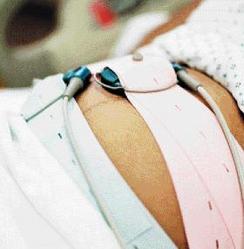Sacha Walters, Staff Reporter

Former health minister John Junor (right) with communications specialist Lisa O'Gilvie, who is on a drive to help women with fibroids. They were at the launch of 'Caribbean Woman 2005 - Addressing Uterine Fibroids', held at the Hilton Kingston hotel, New Kingston, on February 15, 2005. - FILE
Sharonalways had what she describes as a high tummy and a painful period, but she thought nothing of it.
In her late 20s, she became pregnant for the first time, with twins. The pregnancy was plagued with pain and discomfort.
"When I was in my second trimester going into the third, the doctor did an ultrasound," she said. It revealed uterine fibroids.
The tumours are non-cancerous growths of the uterus which usually appear during a woman's childbearing years, according to information from the Mayo Clinic website. They are also called fibromyomas, leiomyomas or myomas. They are not associated with an increased risk of uterine cancer.
"About 20 per cent of women who have fibroids will have symptomatic fibroids, " according to gynaecologist Dr Charles Rockhead. Sharon fell in this group.
Dr Rockhead further explained that the incidence of fibroids increased with age and was linked to its incidence in one's family.
One of the reasons Sharon was shocked when she got her diagnosis was that no female in her family suffered from the condition. She was prescribed medication, but it did little to ease the pain.
"The pain got really worse than before and I realised I was bleeding and I rushed to the hospital." But she would not be able to bring her children to full term.
"The doctor said the fibroids had terminated the pregnancy." She was devastated.
Pregnant again

A year later, pregnant again, the pain was worse. " I looked like I was having triplets," she said. Tests revealed once more that fibroids were the culprit.
This time, her baby was lodged between two tumours, one weighed approximately three pounds.

